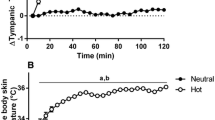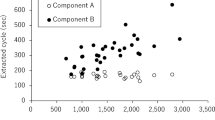Abstract
Spectral analysis of heart rate variability is studied in 10 healthy growing premature infants to investigate the changes in autonomic balance achieved as a function of changes in skin temperature. Heart rate is obtained from ECG recordings and the power spectrum of beat-to-beat heart rate fluctuations is computed. The infants maintain mean rectal temperature within 36.3–37.2°C, while skin temperature changes. The respiratory rate does not change at the different servocontrol set points. Heart rate is found to increase slightly, but consistently. The low-frequency band (0.02–0.2 Hz), reflecting the interplay of the sympathetic and parasympathetic tone and known to be maximum at the thermoneutral zone, is maximum at 35.5 and 36°C and decreases gradually to a lower level at a servocontrol temperature of 36.5–37°C. The high-frequency band (0.2–2.0 Hz), coinciding with the respiratory peak and reflecting parasympathetic activity, is significantly elevated at 36°C (p<0.01). The minimum low: high ratio, indicating the minimum sympathetic-parasympathetic balance and possibly reflecting the most comfortable conditions, occurs at 36°C, although the differences are not statistically significant. Servocontrol skin temperature may thus be adapted, and possibly selected at 36°C for growing premature infants in an attempt to achieve thermal comfort and more balanced autonomic activity.
Similar content being viewed by others
References
Adamsons, K., Gandy, G. M., andJames, L. S. (1965): ‘The influence of thermal factors upon oxygen consumption of the newborn human infant,’J. Pediatr.,66, pp. 495–508
Akselrod, S., Gordon, D., Ubel, F. A., Shannon, D. C., Barger, A. C., andCohen, R. J. (1981): ‘Power spectrum analysis of heart rate fluctuations: a quantitative probe of beat-to-beat cardiovascular control,’Science,213, pp. 220–222
Akselrod, S., Gordon, D., Madwed, J. B., Snidman, N. C., Shannon, D. C., andCohen, R. J. (1985): ‘Hemodynamic regulation: investigation by spectral analysis,’Am. J. Physiol.,249, pp. H867-H875
Akselrod, S. (1988): ‘Spectral analysis of fluctuations in cardiovascular parameters: a quantitative tool for the investigation of autonomic control,’TIPS,9, pp. 6–9
Alcalay, H., Izraeli, S., Wallach-Kapon, R., Tochner, Z., Benjamini, Y., andAkselrod, S. (1991): ‘Pharmacological modulation of vagal cardiac control measured by heart rate power spectrum: a possible bioequivalent probe,’Neurosci. Biobehav. Rev.,15, pp. 51–55
Appel, M. L., Burger, R. D., Saul, J. P., Smith, J. M., andCohen, R. J. (1989): ‘Beat-to-beat variability in cardiovascular parameters: Noise or music,’J. Am. Coll. Cardiol.,14, 1139–1148.
Bach, V., Bouferrache, B., Kremp, Q., Maingourd, Y., andLibert, J. P. (1994): ‘Regulation of sleep and body temperature in response to exposure to cool and warm environments in neonates,’Pediatrics,93,(5), pp. 789–796
Baldzer, K., Dykes, F. D., Jones, S. A., Brogan, M., Carrigan, T. A., andGiddens, D. P. (1989): ‘Heart rate variability analysis in full-term infants; spectral indices for study of neonatal cardioespiratory control,’Pediatr. Res.,26, 188–195
Berger, R. D., Akselrod, S., Gordon, D., andCohen, R. J. (1986): ‘An efficient algorithm for spectral analysis of heart rate variability,’IEEE Trans.,BME-48, pp. 305–307
Bruck, K. (1961): ‘Temperature regulation in the newborn infant’,Biol. Neonate,3, pp. 65–119
Bruck, K., Parmelee, A. H., andBruck, M. (1962): ‘Neutral temperature range and range of ‘thermal comfort’ in premature infants,’Biol. Neonate,4, pp. 32–51
Day, R. L., Caliguiri, L., Kamenski, C., andEhrlich, F. (1964): ‘Body temperature and survival of premature infants,’Pediatrics,34, pp. 171–181
Dykes, F. D., Ahmann, P. A., Baldzer, K., Carrigan, A., Kitney, R. J., andGiddens, D. P. (1986): ‘Breath amplitude modulations of heart rate raviability in normal full term neonates,’Pediatr. Res.,20, pp. 301–308
Fleming, P. J., Levine, M. R., Azaz, Y., andJohnson, P. (1988): ‘The effect of sleep state on the metabolic response to cold stress in newborn infants’,in Jones, C. T. (Ed.): ‘Fetal and neonatal development (Perinatology Press) pp. 635–639
Hey, E. N. (1969): ‘The relation between environmental temperature and oxygen consumption in the new-born baby,’J. Physiol.,200, pp. 589–603
Hey, E. N., andKatz, G. (1970): ‘The optimum thermal environment for naked babies,’Arch. Dis. Child.,45, pp. 328–334
Hey, E. N. (1975): ‘Thermal neutrality,’Br. Med. Bull.,31, pp. 69–74
Hill, J. R., andRahimtulla, K. A. (1965): ‘Heat balances and the metabolic rate of new-born babies in relation to environmental temperature; and the effect of age and of weight on basal metabolic rate,’J. Physiol.,180, pp. 239–265
Hull, D., andSegall, M. M. (1965): ‘Sympathetic nervous control of brown adipose tissue and heat production in the newborn rabbit’,J. Physiol.,181, pp. 458–467
Jahnukainen, T., Van-Ravenswaaij-Arts, C., Jalonen, J., andValimaki, I. (1993): ‘Dynamics of vasomotor thermoregulation of the skin in term and preterm neonates,’Early Hum. Dev.,33,(2), pp. 133–143
Jahnukainen, T., Lindqvist, A., Jalonen, J., Kero, P., andValimaki, I. (1996): ‘Reactivity of skin blood flow and heart rate to thermal stimulation in infants during the first postnatal days and after a two-month follow-up,’Acta Paediatr.,85, pp. 733–738
Kitney, R. I., andRompelman, O. (Eds) (1980): ‘The study of heart rate variability’, (Clarendon Press, Oxford)
Lindqvist, A., Oja, R., Hellman, O., andValimaki, I. (1983): ‘Impact of thermal vasomotor control on the heart rate variability of newborn infants,’Early Hum. Dev.,8, (1), pp. 37–47
Lossius, K., Eriksen, M., andWalloe, L. (1993): ‘Fluctuations in blood flow to acral skin in humans: connection with heart rate and blood pressure variability,’J. Physiol.,460, pp. 641–655
Lossius, K., andEriksen, M. (1994): ‘Connection between skin arteriovenous anastomoses flow fluctuations and heart rate variability in infants,’Early Hum. Dev.,39, pp. 69–82
Lossius, K., Eriksen, M., andWalloe, L. (1994): ‘Thermoregulatory fluctuations in heart rate and blood pressure in humans: effect of cooling and parasympathetic blockade,’J. Auton. Nerve Sys.,47, pp. 245–254
Malliani, A., Pagani, M., Lombardi, F., andCerutti, S. (1991): ‘Cardiovascular neural regulation explored in the frequency domain,’Circulation,84, pp. 482–492
Malliani, A. (1995): ‘Association of heart rate variability components with physiogical regulatory mechanisms’,in edited by Malik, M., and John Camm AT, ‘Heart rate variability’ (Futura Publishing Company, Inc.)
Oz, O., Eliash, S., Cohen, S., andAkselrod, S. (1989): ‘The effect of changes in blood volume on low frequency blood pressure fluctuations in spontaneously hypertensive rats,’IEEE Trans. Comput. in Cardiol.,89, pp. 61–64
Pagani, M., Lombardi, F., Guzzetti, S., Rimoldi, O., Furlan, R., Pizzinelli, P., Sandrome, G., Malfatto, G., Dell’Orto, S., Piccaluga, E., Turiel, M., Baselli, G., Cerutti, S., andMalliani, A. (1986): ‘Power spectral analysis of heart-rate and arterial pressure variabilities as a marker of sympathovagal interaction in man and conscious dog,’Circ. Res.,59, pp. 178–193
Perlstein, P. H. (1983): ‘Physical environment’,in Behrman, R. E. (Ed.): ‘Neonatal-perinatal medicine’ (CV Mosby Company, St. Louis, Toronto) pp. 259–277
Pomeranz, B., Maccauley, R. J. B., Caudill, M. A., Kutz, I., Adam, D., Gordon, D., Kilborn, K. M., Barger, A. C., Shannon, D. C., Cohen, R. J., andBenson, H. (1985): ‘Assessment of autonomic function in humans by heart rate spectral analysis,’Am. J. Physiol. 248, pp. H151-H153
Sauer, P. J. J., Dane, H. J., andVisser, H. K. A. (1984): ‘New standards for neutral thermal environment of healthy very low birthweight infants in week one of life,’Arch. Dis. Child.,59, pp. 18–22
Scopes, J. W., andAhmed, I. (1966): ‘Range of critical temperature in sick and premature newborn babies,’Arch. Dis. Child. 41, 417–419
Shefi, O., Davidson, S., Maayan, A., andAkselrod, S. (1995): ‘Contribution of thermal entrainment of the heart rate variability in neonates using spectral analysis Medicon VII Mediterranean Conf. on Medical & Biological Engineering
Silverman, W. A., Fertig, J. W., andBerger, A. P. (1958): ‘The influence of the thermal environment upon the survival of newly born premature infants,’Pediatrics,22, pp. 876–885
Swyer, P. R. (1978): ‘Heat loss after birth’in Sinclair, J. C. (Ed.). ‘Temperature regulation and energy metabolism in the newborn. (Grune and Stratton, New York) pp. 91–129
Telliez, F., Bach, V., Krin, G., Kabexa, B., andLibert, J. P. (1997): ‘Consequences of a small decrease of air temperature from thermal equilibrium on thermoregulation in sleeping newborns’,Med. Biol. Eng. Comput.,35, pp. 516–520
Wheldon, A. E., andHull, D. (1983): ‘Incubation of very immature infants,’Arch. Dis. Chil.,58, pp. 504–508
Author information
Authors and Affiliations
Corresponding author
Rights and permissions
About this article
Cite this article
Davidson, S., Reina, N., Shefi, O. et al. Spectral analysis of heart rate fluctuations and optimum thermal management for low birth weight infants. Med. Biol. Eng. Comput. 35, 619–625 (1997). https://doi.org/10.1007/BF02510969
Received:
Accepted:
Issue Date:
DOI: https://doi.org/10.1007/BF02510969




